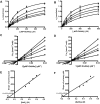Azide anions inhibit GH-18 endochitinase and GH-20 Exo β-N-acetylglucosaminidase from the marine bacterium Vibrio harveyi
- PMID: 26330565
- PMCID: PMC4892774
- DOI: 10.1093/jb/mvv087
Azide anions inhibit GH-18 endochitinase and GH-20 Exo β-N-acetylglucosaminidase from the marine bacterium Vibrio harveyi
Abstract
Vibrio harveyi is a bioluminescent marine bacterium that utilizes chitin as its sole source of energy. In the course of chitin degradation, the bacterium primarily secretes an endochitinase A (VhChiA) to hydrolyze chitin, generating chitooligosaccharide fragments that are readily transported into the cell and broken down to GlcNAc monomers by an exo β-N-acetylglucosaminidase (VhGlcNAcase). Here we report that sodium salts, especially sodium azide, inhibit two classes of these chitin-degrading enzymes (VhChiA and VhGlcNAcase) with distinct modes of action. Kinetic analysis of the enzymatic hydrolysis of pNP-glycoside substrates reveals that sodium azide inhibition of VhChiA has a mixed-type mode, but that it inhibits VhGlcNAcase competitively. We propose that azide anions inhibit chitinase activity by acting as strong nucleophiles that attack Cγ of the catalytic Glu or Cβ of the neighbouring Asp residues. Azide anions may bind not only to the catalytic centre, but also to the other subsites in the substrate-binding cleft of VhChiA. In contrast, azide anions may merely occupy the small-binding pocket of VhGlcNAcase, thereby blocking the accessibility of its active site by short-chain substrates.
Keywords: chitin turnover; family 18 chitinase; family 20 N-acetylglucosaminidase; reversible inhibition; sodium azide.
© The Authors 2015. Published by Oxford University Press on behalf of the Japanese Biochemical Society. All rights reserved.
Figures








Similar articles
-
NAG-thiazoline is a potent inhibitor of the Vibrio campbellii GH20 β-N-Acetylglucosaminidase.FEBS J. 2020 Nov;287(22):4982-4995. doi: 10.1111/febs.15283. Epub 2020 Mar 23. FEBS J. 2020. PMID: 32145141
-
Role of Tyr-435 of Vibrio harveyi chitinase A in chitin utilization.Appl Biochem Biotechnol. 2012 Mar;166(5):1192-202. doi: 10.1007/s12010-011-9504-8. Epub 2011 Dec 23. Appl Biochem Biotechnol. 2012. PMID: 22194054
-
The chitin-binding domain of a GH-18 chitinase from Vibrio harveyi is crucial for chitin-chitinase interactions.Int J Biol Macromol. 2016 Dec;93(Pt A):1111-1117. doi: 10.1016/j.ijbiomac.2016.09.066. Epub 2016 Sep 22. Int J Biol Macromol. 2016. PMID: 27667544
-
Enzymatic properties of β-N-acetylglucosaminidases.Appl Microbiol Biotechnol. 2018 Jan;102(1):93-103. doi: 10.1007/s00253-017-8624-7. Epub 2017 Nov 16. Appl Microbiol Biotechnol. 2018. PMID: 29143882 Review.
-
The broad-specificity chitinases: their origin, characterization, and potential application.Appl Microbiol Biotechnol. 2019 Apr;103(8):3289-3295. doi: 10.1007/s00253-019-09718-x. Epub 2019 Mar 8. Appl Microbiol Biotechnol. 2019. PMID: 30850873 Review.
Cited by
-
Structural basis of chitin utilization by a GH20 β-N-acetylglucosaminidase from Vibrio campbellii strain ATCC BAA-1116.Acta Crystallogr D Struct Biol. 2021 May 1;77(Pt 5):674-689. doi: 10.1107/S2059798321002771. Epub 2021 Apr 27. Acta Crystallogr D Struct Biol. 2021. PMID: 33950022 Free PMC article.
-
The Effect of Fucoidan from the Brown Alga Fucus evanescence on the Activity of α-N-Acetylgalactosaminidase of Human Colon Carcinoma Cells.Mar Drugs. 2018 May 10;16(5):155. doi: 10.3390/md16050155. Mar Drugs. 2018. PMID: 29748462 Free PMC article.
-
Advanced screening methods for assessing motility and hatching in plant-parasitic nematodes.Plant Methods. 2024 Jul 20;20(1):108. doi: 10.1186/s13007-024-01233-z. Plant Methods. 2024. PMID: 39033124 Free PMC article.
-
Probing the Catalytic Mechanism of Vibrio harveyi GH20 β-N-Acetylglucosaminidase by Chemical Rescue.PLoS One. 2016 Feb 12;11(2):e0149228. doi: 10.1371/journal.pone.0149228. eCollection 2016. PLoS One. 2016. PMID: 26870945 Free PMC article.
References
-
- Bassler B.L., Yu C., Lee Y.C., Roseman S. (1991) Chitin utilization by marine bacteria. J. Biol. Chem. 266, 24276–24286 - PubMed
-
- Cohen-Kupiec R., Chet I. (1998) The molecular biology of chitin digestion. Curr. Opin. Biotechnol. 9, 270–277 - PubMed
-
- Suginta W., Vongsuwan A., Songsiriritthigul C., Svasti J., Prinz H. (2005) Enzymatic properties of wild-type and active site mutants of chitinase A from Vibrio carchariae, as revealed by HPLC-MS. FEBS J. 272, 3376–3386 - PubMed
-
- Matsuo Y., Kurita M., Park J.K., Tanaka k., Nakagawa T., Kawamukai M., Matsuda H. (1999) Purification, characterization and gene analysis of N-acetylglucosaminidase from Enterobacter sp. G-1. Biosci. Biotechnol. Biochem . 63, 1261–1268 - PubMed
Publication types
MeSH terms
Substances
LinkOut - more resources
Full Text Sources
Other Literature Sources
Miscellaneous

